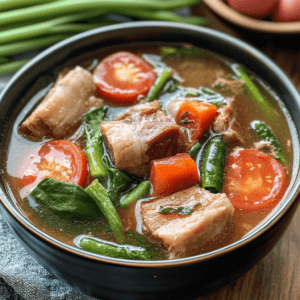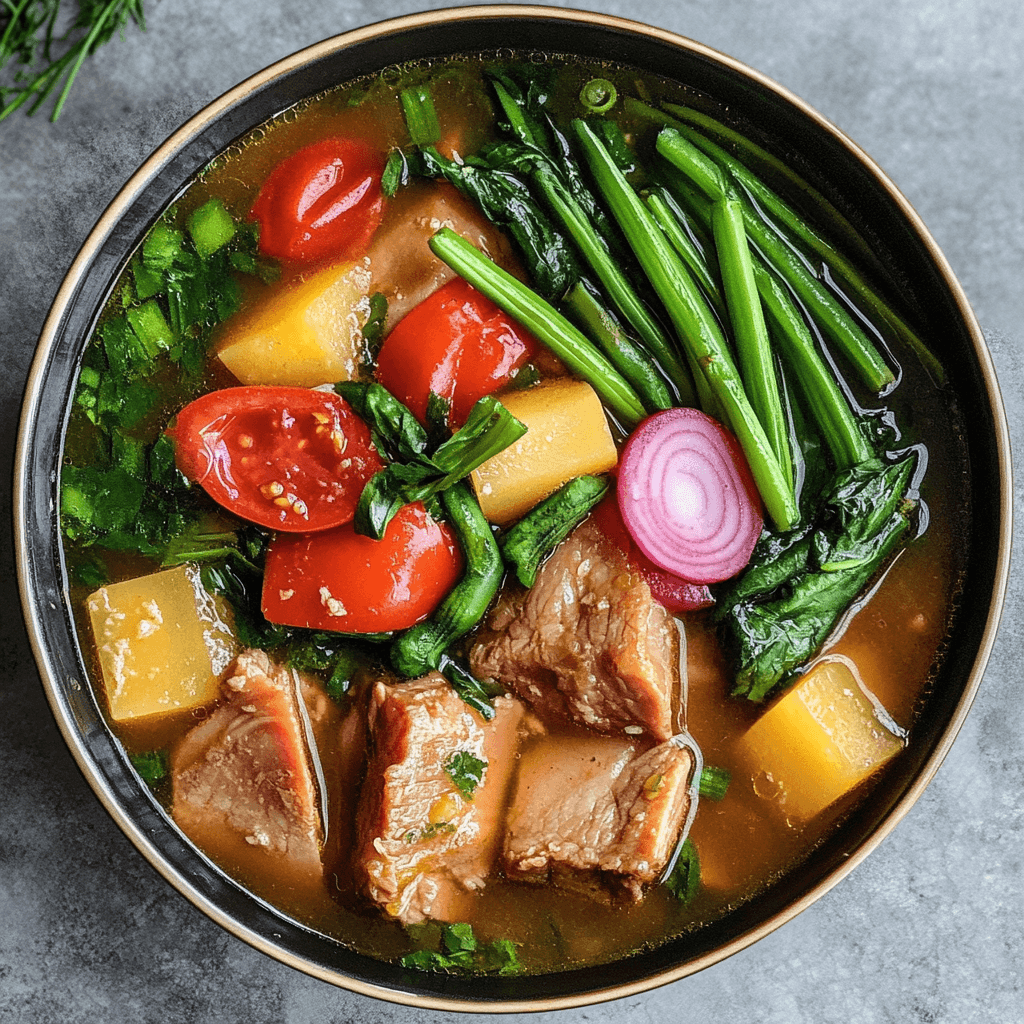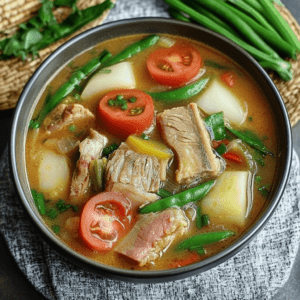People often ask, is Filipino sinigang healthy? This iconic dish offers a combination of fresh, nutrient-dense ingredients. Many people ask, is Filipino sinigang healthy? This traditional soup combines fresh ingredients, offering various health benefits. Filipino sinigang is more than just a comforting bowl of soup; it’s a staple in Filipino cuisine known for its tangy flavor and rich ingredients. But is Filipino sinigang healthy? Let’s dive into the details to understand its nutritional benefits and how it fits into a healthy lifestyle.
Is Filipino Sinigang Healthy? Understanding Its Nutritional Value
What is Sinigang and Is It Healthy?
Sinigang is a traditional Filipino soup characterized by its sour broth, typically made with tamarind, tomatoes, and various vegetables. It’s often prepared with proteins like pork, beef, shrimp, or fish, making it a versatile and hearty meal option. The sourness can also be achieved using other souring agents such as calamansi, green mango, or bilimbi, each adding a unique twist to the flavor profile.
History and Cultural Significance of Sinigang
Understanding the health benefits of sinigang also involves appreciating its cultural roots. Sinigang holds a special place in Filipino culture, representing more than just a meal but a symbol of family and togetherness. Originating from rural areas, it was a dish that utilized readily available ingredients, showcasing the resourcefulness of Filipino households. Over time, sinigang has evolved, incorporating various regional ingredients and techniques, yet it remains a beloved comfort food across the Philippines. It’s commonly served during family gatherings, celebrations, and everyday meals, emphasizing its role in fostering communal bonds.
Is Filipino Sinigang Healthy? Nutritional Benefits Explained
Essential Nutrients in Sinigang
When exploring is sinigang good for you?, it’s essential to look at its nutritional components. Sinigang is packed with essential nutrients that contribute to overall health. Its combination of proteins, vegetables, and broth provides a balanced mix of vitamins and minerals crucial for bodily functions.
Nutritional Value of Sinigang: Vitamins and Minerals Explained
The vegetables used in sinigang, such as spinach, radish, and eggplant, are rich in vitamins A and C, calcium, and potassium. Vitamin A is vital for maintaining healthy vision and immune function, while vitamin C boosts the immune system and aids in the absorption of iron. Calcium is essential for strong bones and teeth, and potassium helps regulate blood pressure and fluid balance in the body.
Proteins and Carbohydrates in Sinigang
Depending on the protein source, sinigang offers a good amount of lean protein, which is essential for muscle repair and growth. Proteins from fish or shrimp are not only low in fat but also provide omega-3 fatty acids, beneficial for heart health. The inclusion of rice as a side provides carbohydrates for energy, making the meal balanced and sustaining.
Caloric Content and Dietary Considerations in Sinigang
A typical serving of sinigang is relatively low in calories, making it suitable for those monitoring their caloric intake. The broth-based nature of the soup ensures that it is filling without being overly heavy. However, the total caloric content can vary based on the ingredients and portion sizes. For instance, using lean meats and a variety of vegetables keeps the calorie count moderate, whereas adding fatty cuts of meat or more starchy vegetables can increase it.
Health Benefits of Eating Sinigang: Sinigang for Wellness
Boosting Immune System with Sinigang
One of the primary reasons is sinigang good for you? is due to its ability to boost the immune system. The high vitamin C content from vegetables and tamarind helps strengthen the immune system, protecting the body against common illnesses like the flu and colds. Regular consumption of vitamin C-rich foods has been linked to reduced severity and duration of respiratory infections.
Aiding Digestion through Sinigang
Sinigang’s tangy broth stimulates digestive enzymes, promoting better digestion and preventing issues like bloating and constipation. The acidic nature of the soup aids in breaking down food more efficiently, enhancing nutrient absorption and overall digestive health.
Promoting Heart Health with Sinigang
The use of lean proteins and vegetables high in potassium can help maintain healthy blood pressure levels, reducing the risk of heart disease. Potassium plays a crucial role in balancing sodium levels in the body, which is essential for cardiovascular health. Additionally, omega-3 fatty acids found in fish-based sinigang contribute to lowering bad cholesterol levels.
Supporting Bone Health with Sinigang
With ingredients like spinach and other leafy greens, sinigang provides calcium and magnesium, which are vital for maintaining strong bones and preventing osteoporosis. Regular intake of these minerals supports bone density and overall skeletal health.
Enhancing Skin Health through Sinigang
Vitamins A and C in sinigang contribute to healthy skin by promoting collagen production and protecting against oxidative stress. Collagen is essential for skin elasticity and preventing signs of aging, while antioxidants from vitamin C help combat free radicals that can damage skin cells.
Reducing Inflammation with Sinigang
Certain ingredients in sinigang, such as ginger and turmeric, possess anti-inflammatory properties. These spices can help reduce inflammation in the body, alleviating symptoms of arthritis and other inflammatory conditions.
Supporting Weight Management with Sinigang
Sinigang is low in calories but high in nutrients and fiber, making it a satisfying meal that can aid in weight management. The fiber content helps in promoting satiety, reducing overall calorie intake by curbing hunger between meals.
Improving Mental Health through Sinigang
Nutrients like omega-3 fatty acids and vitamins B6 and B12 found in sinigang contribute to brain health, improving mood and cognitive function. A well-balanced diet that includes such nutrients is linked to lower rates of depression and anxiety.
Detoxifying the Body with Sinigang
The high water content in sinigang aids in flushing out toxins from the body, supporting kidney function and overall detoxification processes. Additionally, the antioxidants present help neutralize harmful free radicals, further contributing to the body’s natural detox mechanisms.
Enhancing Energy Levels with Sinigang
With a balanced mix of carbohydrates, proteins, and vitamins, sinigang provides sustained energy levels throughout the day. The complex carbohydrates from rice offer a steady release of energy, preventing spikes and crashes in blood sugar levels.
Potential Health Concerns: Sinigang and Health
Sodium Levels and Blood Pressure in Sinigang
While sinigang offers numerous health benefits, it’s important to address potential health concerns. One consideration is the sodium content in sinigang, especially when using store-bought broths or adding extra salt. High sodium intake can lead to elevated blood pressure, increasing the risk of heart disease and stroke. To mitigate this, it’s advisable to use low-sodium broths, limit added salt, and incorporate fresh ingredients that enhance flavor without relying heavily on salt.
Allergens and Food Sensitivities in Sinigang
Some variations of sinigang may include ingredients like shellfish, which can be allergens for some individuals. It’s crucial to be aware of the ingredients to avoid adverse reactions. Substituting with hypoallergenic proteins like chicken or tofu can make sinigang accessible to those with specific food sensitivities.
Caloric Density with Fatty Meats in Sinigang
Using fatty cuts of meat can increase the caloric density of sinigang, potentially contributing to weight gain if consumed in large quantities. Opting for leaner protein sources like fish, shrimp, or lean cuts of pork and beef can help maintain a healthier calorie profile.
Oxalate Content in Vegetables Used in Sinigang
Certain vegetables used in sinigang, such as spinach, are high in oxalates, which can contribute to kidney stone formation in susceptible individuals. Moderation and variety in vegetable selection can help minimize this risk while still enjoying the nutritional benefits.
Sinigang Variations and Their Health Impacts: Sinigang Nutritional Benefits
Vegetarian vs. Meat-Based Sinigang
When pondering the health benefits of sinigang, considering the variations is essential. Vegetarian sinigang, made with tofu or mushrooms, offers lower saturated fat content compared to meat-based versions, making it a healthier option for those seeking plant-based diets. Plant-based proteins also provide additional fiber and phytonutrients that support overall health.
Different Broths and Their Benefits in Sinigang
Using different souring agents like calamansi or green mango can alter the nutritional profile of sinigang, adding variety and potentially enhancing certain health benefits. For example, calamansi is rich in vitamin C and antioxidants, while green mango provides additional fiber and digestive enzymes.
Incorporation of Seaweed in Sinigang
Some modern variations include seaweed, which is rich in iodine and other trace minerals. Seaweed can enhance thyroid function and provide additional vitamins and minerals, further boosting the health benefits of sinigang.
Gluten-Free Options in Sinigang Recipes
Traditional sinigang is naturally gluten-free, but it’s important to ensure that any additional ingredients or condiments used are also free from gluten to cater to individuals with celiac disease or gluten sensitivities.
Comparing Sinigang to Other Traditional Soups: Sinigang and Health
Sinigang vs. Pho: A Nutritional Comparison
While both are hearty soups, sinigang typically contains more vegetables and a tangier broth, offering different nutritional benefits compared to the herb-heavy Vietnamese pho. Pho often includes noodles, which can increase the carbohydrate content, whereas sinigang focuses more on proteins and vegetables, providing a balanced nutrient profile with fewer carbs.
Sinigang vs. Tom Yum: Flavor and Health Benefits
Tom Yum is known for its spicy and sour flavor, similar to sinigang. However, sinigang may have a higher protein content depending on the ingredients used. Both soups are rich in vitamins and minerals, but sinigang’s milder spice level makes it more accessible to those sensitive to heat, while Tom Yum’s spiciness can offer metabolism-boosting benefits.
Sinigang vs. Miso Soup: A Health Perspective
Miso soup, a staple in Japanese cuisine, is typically lighter and focuses on fermented soybean paste, offering probiotics for gut health. In contrast, sinigang is more robust with a variety of vegetables and proteins, providing a more substantial meal option with a diverse nutrient profile.
Incorporating Sinigang into a Balanced Diet: Sinigang as a Healthy Meal
Serving Sizes and Frequency for a Healthy Sinigang Diet
Enjoying sinigang in moderate portions and incorporating it regularly can contribute to a balanced diet without overconsuming calories or sodium. It’s an excellent choice for a main dish, providing essential nutrients without excessive caloric intake. Balancing sinigang with other meals that include whole grains, fruits, and healthy fats ensures a well-rounded diet.
Pairing Sinigang with Other Healthy Foods
Serving sinigang with brown rice or whole grains can enhance its nutritional value, providing additional fiber and nutrients. Including a side of fresh vegetables or a salad can further boost the meal’s vitamin and mineral content, creating a more comprehensive and satisfying dining experience.
Meal Prepping with Sinigang for Wellness
Preparing sinigang in bulk can be an efficient way to incorporate it into your weekly meal plan. It stores well in the refrigerator and can be easily reheated, making it a convenient option for busy lifestyles. Portioning out servings ensures controlled calorie intake and balanced nutrient distribution throughout the week.
Adapting Sinigang for Various Dietary Restrictions
Sinigang is highly adaptable, allowing for modifications to suit various dietary needs. Whether you’re following a low-sodium, vegetarian, or gluten-free diet, sinigang can be adjusted by selecting appropriate ingredients and cooking methods, ensuring it remains a versatile and inclusive meal choice.
Health Benefits of Sinigang: A Complete Overview
Nutritionists’ Perspectives on Sinigang Health Benefits
Nutritionists often praise sinigang for its high vegetable content and lean proteins, highlighting its role in a balanced diet when prepared healthily. They emphasize the importance of using fresh, seasonal vegetables and lean cuts of meat to maximize its health benefits. Additionally, the soup’s hydrating properties and low caloric density make it an excellent option for weight management and overall wellness.
Culinary Experts’ Insights on Sinigang as a Healthy Dish
Chefs and culinary experts appreciate sinigang’s versatility and ability to incorporate a wide range of nutritious ingredients, making it both delicious and healthy. They commend its adaptability to various dietary preferences and its capacity to showcase the richness of Filipino culinary traditions. Culinary professionals also highlight the importance of balancing flavors and textures to enhance the eating experience while maintaining its health benefits.
Medical Professionals’ Views on Sinigang’s Nutritional Value
Medical professionals recognize the benefits of sinigang’s nutrient-dense ingredients in promoting overall health. They point out that the high intake of vitamins, minerals, and antioxidants found in sinigang can support immune function, bone health, and cardiovascular wellness. However, they also caution about the potential high sodium content in some recipes, advising moderation and mindful ingredient selection.

Frequently Asked Questions (FAQs)
1. Can sinigang help with weight loss?
Yes, sinigang is low in calories and high in vegetables, making it a suitable option for those looking to manage their weight. Its high fiber content promotes satiety, reducing the likelihood of overeating and supporting weight loss efforts.
2. Is sinigang gluten-free?
Generally, sinigang is gluten-free, but it’s important to check the ingredients used, especially if using store-bought broths or seasonings. Some commercial products may contain gluten as a thickener or flavor enhancer, so opting for natural, homemade broths ensures gluten-free compliance.
3. How can I reduce the sodium content in sinigang?
You can reduce sodium by using low-sodium broths, limiting added salt, and incorporating fresh ingredients that enhance flavor without extra salt. Additionally, using herbs and spices like garlic, ginger, and chili can add depth to the broth without relying on sodium.
4. What are the best vegetables to use in sinigang?
Common vegetables include spinach, radish, eggplant, okra, and green beans, which add both nutrition and flavor to the dish. Other additions like taro, tomatoes, and string beans can also enhance the nutritional profile and taste of sinigang.
5. Can sinigang be made vegan?
Yes, by substituting animal proteins with tofu or mushrooms and ensuring all ingredients are plant-based, sinigang can be made vegan-friendly. Using vegetable broths and incorporating a variety of plant proteins ensures a satisfying and nutritious vegan sinigang.
6. What are some alternative souring agents for sinigang?
Apart from tamarind, you can use calamansi, green mango, or even vinegar to achieve the desired tangy flavor. Each souring agent imparts a unique taste, allowing you to customize sinigang to your preference while maintaining its essential characteristics.
Conclusion: Is Filipino Sinigang Healthy?
In conclusion, is Filipino sinigang healthy? Yes, when prepared with fresh vegetables, lean proteins, and moderated sodium levels, sinigang is a nutritious and balanced meal option that offers numerous health benefits. Its rich combination of vitamins, minerals, and antioxidants supports various aspects of health, from immune function to heart health. By making mindful ingredient choices and portion control, sinigang can be a delightful and wholesome addition to a balanced diet. So, is Filipino sinigang healthy? Yes! Its ingredients provide essential nutrients while offering a delicious meal for any occasion.
Related article:
The Ultimate Guide to Sinigang Recipe: A Timeless Filipino Classic


